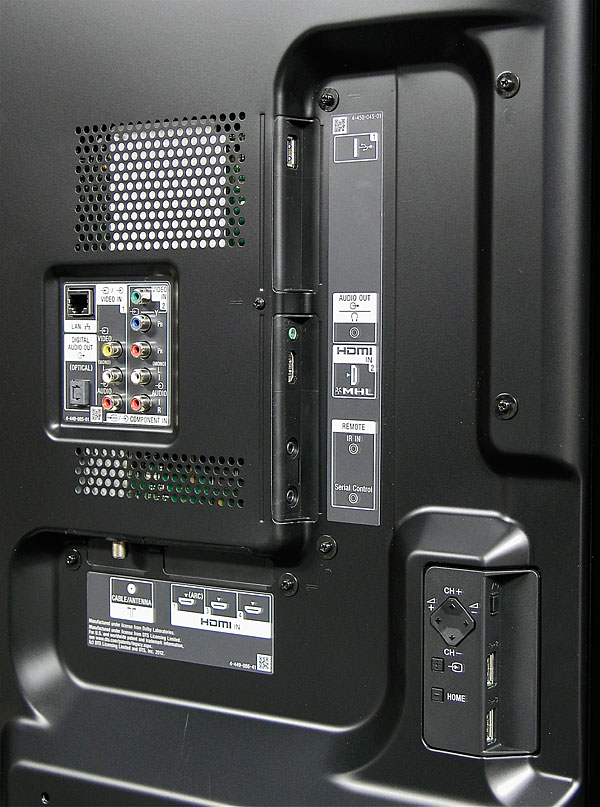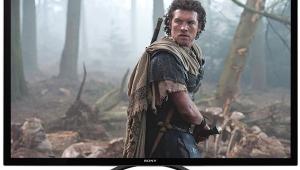Sony KDL-55W900A 3D LCD HDTV

Price: $3,300 At A Glance: Rich black level and good shadow detail • New color technology • Bright, punchy 3D
The new KDL-55W900A is Sony’s newest, top-of-the-line, non-XBR set. All of the XBRs, going forward, will be Ultra HD (4K) sets, but the KDL-55W900A, as all of the KDL designs, is firmly in the standard HD, 1920 x 1080 camp. It’s an edge-lit design with local dimming, but its marquee feature has nothing to do with contrast and black levels. Color is the plot here, and Triluminos, a term Sony has used in the past (see sidebar), promises a wider color gamut. Normally, we’d take this claim with raised eyebrows, as most current consumer video sources (apart from a few camcorders) use the smaller, HD color gamut standard (Rec. 709). A new disturbance in the force, however, might just belay this objection. But I’m getting in front of myself.
Feature Shock
With its swiveling stand and near frameless look, the KDL-55W900A is noticeably smaller than the XBR-55HX950 we reviewed recently (Home Theater, February/March 2013), though its screen size is the same. But it is bigger in one respect; it’s slightly deeper. That’s said to be the result of Sony’s attempts to improve the set’s audio. With a limited bass extension that turns noticeably tubby if pushed too hard, it’s still no substitute for even a modest outboard audio system. But there’s a fuller and more listenable balance than most flat panels can manage, and Sony’s new audio improvement efforts can be considered a modest but welcome success. On the other hand, those who plan to bolster the KDL-55W900A’s audio with a soundbar should note that its optical audio output will not pass multichannel Dolby Digital or DTS bitstream signals and instead converts audio from all HDMI sources to stereo PCM. This may cramp performance if the soundbar has built-in decoders to take advantage of DD or DTS signals.
The set offers more picture modes than anyone could possibly need. I chose Cinema 1 for all of my tests and viewing. I also left many of Sony’s specialized features off—for us, such things as Black Corrector, Auto Light Limiter, Live Color, and Clear White are unnecessary for anyone who wants an accurate reproduction of the source material.
Sony’s motion-smoothing features are Motionflow and Smooth Gradation. In most settings, they incorporate frame interpolation. While some settings of these controls are less bothersome than others, I continue to find that frame interpolation kills the film-look of movies and left both of these controls off for all of my viewing.

An HDTV generally plays at a refresh rate that’s a multiple of the source’s frame rate. For a 24-hertz (frames per second) source, for example, the refresh rate can be 48 Hz, 72 Hz, 96 Hz, 120 Hz, etc. (48 Hz isn’t fast enough to eliminate visible flicker, 72 Hz is rarely used, and only even multiples of 24 Hz will work in a set using active glasses for 3D.) In the past, some sets (though none of Sony’s) have used 3:2 pulldown to convert an incoming 24-Hz source to 60 Hz. This can simplify the design process but potentially introduce video artifacts. According to Sony, the KDL-55W900A’s native refresh rate is such that it can play back 24-Hz sources (2D, 2D converted to 3D by the set, and native 3D) at appropriate direct multiples of 24 Hz without first using 3:2 pulldown to convert the 24-Hz source to 60 Hz.
The set provides both high (Gain) and low (Bias) White Balance controls for calibration, but as with all Sony sets we’ve seen so far, it has no user color management system (CMS).
The 3D controls include a 2D-to-3D conversion mode and a 3D Glasses Brightness adjustment. The newest Sony active 3D glasses (the TDG-BT500A—four pair come with the set, extras are $49/pair) are light and battery powered but not rechargeable. The 3D active glasses may also be used with PlayStation games incorporating SimulView (not tested), allowing each player to see only the images pertinent to his or her part of the action. The picture in this case will be 2D.
 The main remote control is backlit and intelligently configured. There’s a second, smaller remote that offers most of the main remote’s features, but it isn’t backlit and its flush buttons are difficult to locate in the dark.
The main remote control is backlit and intelligently configured. There’s a second, smaller remote that offers most of the main remote’s features, but it isn’t backlit and its flush buttons are difficult to locate in the dark.
Downloadable apps (not tested) also enable the use of either a smartphone or PC as a remote. Sony has left its XrossMediaBar menu behind for a new one, with a Home screen that’s far easier and more intuitive to navigate. A separate Options button, however, offers faster access to some of the set’s features, including the video adjustments.
No self-respecting HDTV would be seen in public today without a range of Internet features, accessible through either a wired LAN connection or wirelessly. The KDL-55W900A (which has built-in Wi-Fi) offers most of the usual Internet apps, including Netflix, Amazon, YouTube, Hulu Plus, Skype, etc., but not Vudu. You can also download firmware updates for the set and play back videos, photos, or music either directly from a USB storage device or from your home network.
Two Dimensions
While the Sony passed most of our standard video tests, it failed both the HD and SD MA (motion adaptive) tests, displaying clearly visible jaggies on both. In my limited viewing of 480i material, however, visible artifacts were not an issue.
The KDL-55W900A’s edge-lit zone dimming (engaged through the LED Dynamic Control) is effective and in fact is mandatory in getting the best blacks from the set. But it’s not as effective as full-array LED backlighting in holding black areas of the screen fully black in the presence of bright details elsewhere in the picture (more on this in “Comparisons,” later). Nevertheless, this Sony’s black level and contrast are excellent by any reasonable standard. And apart from a very slight lightening of the sides with a fully black screen in some situations in which the LEDs do not shut down completely (most obvious in 3D), the set’s black uniformity (and its white uniformity as well) is hard to criticize. There are no gnomes with tiny flashlights hiding behind the borders of the picture!
- Log in or register to post comments




































































